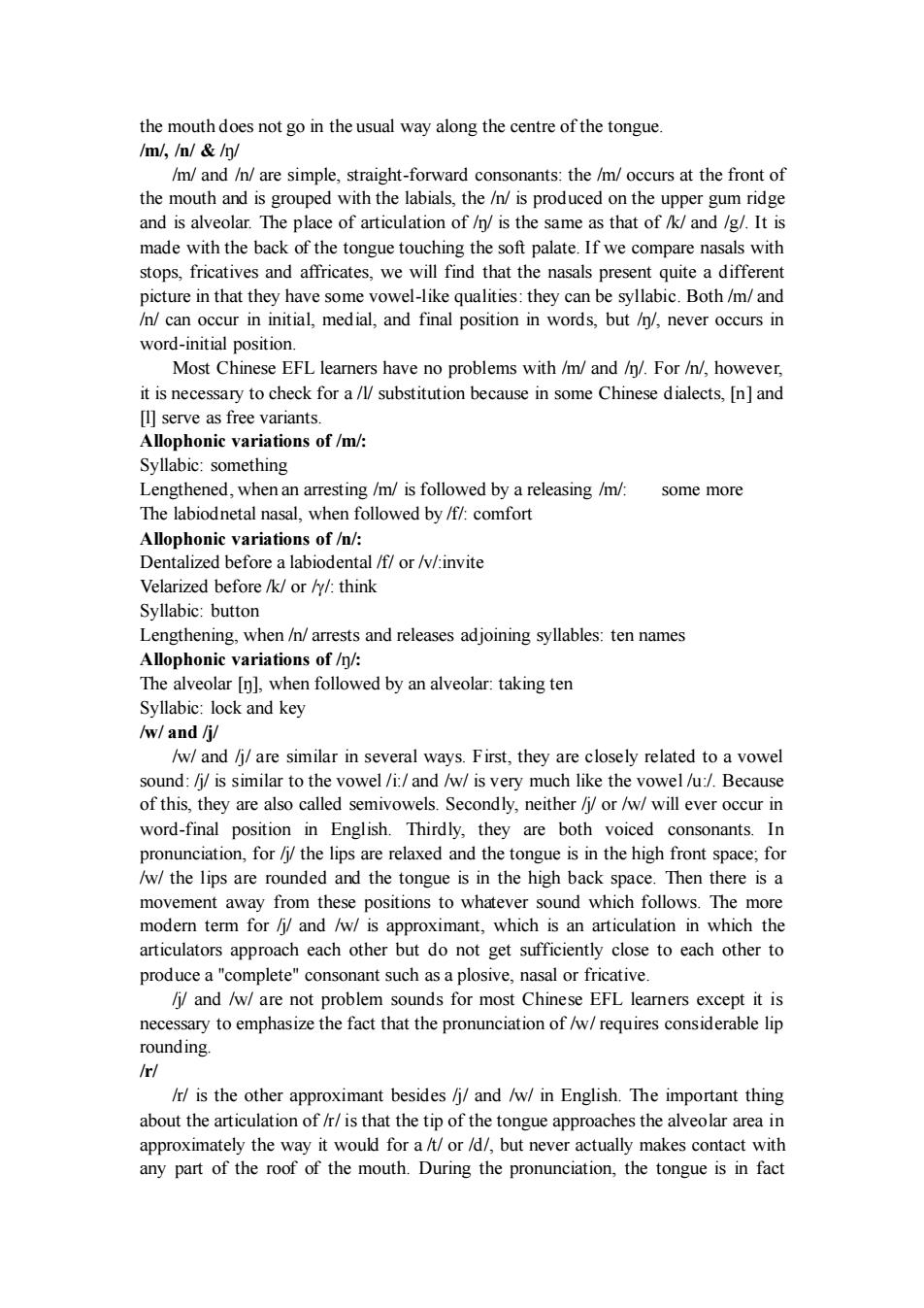正在加载图片...

the mouth does not go in the usual way along the centre of the tongue /m/and /n/are simple,straight-forward consonants:the /m/occurs at the front of the mouth and is grouped with the labials,the /n/is produced on the upper gum ridge and is alveolar.The place of articulation of/n/is the same as that of /k/and /g/.It is made with the back of the tongue touching the soft palate.If we compare nasals with stops,fricatives and affricates,we will find that the nasal present quite ea differer picture in that they have some vowel-like qualities:they can be syllabic.Both/m/and /n/can occur in initial,med ial,and final position in words,but /n/,never occurs in word-initial position. Most Chinese EFL learners have no problems with/m/and /n/.For/n/however it is necessary to check for a/substitution because in some Chinese dialects,[n]and serve as free Allophonic variations of /m/ Svllabic:something Lengthened,when an arresting /m/is followed by a releasing /m/: some more The labiodnetal nasal,when followed by /f/:comfort A llophoni c variatio s of /n/ Dentalized before a labiodental /f/or/v/invite Velarized before/k/or /y/:think Syllabic:button Lengthening,when/n/arrests and releases adjoining syllables:ten names variations of The alveolar when followed by an alveolar:taking ten Syllabic:lock and key w/and /i/ /w/and /i/are similar in several ways.First,they are closely related to a vowel sound:to the is uch like the owel/u/.Bec of this they are also cal lled semivow dly,neither j/or ill ever occur word-final position in English.Thirdly,they are both voiced consonants.In pronunciation,for j/the lips are relaxed and the tongue is in the high front space;for /w/the lips are rounded and the tongue is in the high back space.Then there is a ound which follows The more moder nt,which in which the produce a"complete"consonant such as a plosive,nasal or fricative. /i/and /w/are not problem sounds for most Chinese EFL learners except it is neces ssary to emphasize the fact that the pronunciation of/w/requires considerable lip ounding r/is the other approximant besides/j/and /w/in English.The important thing about the articulation of/r/is that the tip of the tongue approaches the alveolar area in approximately the way it would for a /t/or/d/,but never actually makes contact with any part of the roof of the mouth.During the pronunciation,the tongue is in factthe mouth does not go in the usual way along the centre of the tongue. /m/, /n/ & /ŋ/ /m/ and /n/ are simple, straight-forward consonants: the /m/ occurs at the front of the mouth and is grouped with the labials, the /n/ is produced on the upper gum ridge and is alveolar. The place of articulation of /ŋ/ is the same as that of /k/ and /g/. It is made with the back of the tongue touching the soft palate. If we compare nasals with stops, fricatives and affricates, we will find that the nasals present quite a different picture in that they have some vowel-like qualities: they can be syllabic. Both /m/ and /n/ can occur in initial, medial, and final position in words, but /ŋ/, never occurs in word-initial position. Most Chinese EFL learners have no problems with /m/ and /ŋ/. For /n/, however, it is necessary to check for a /l/ substitution because in some Chinese dialects, [n] and [l] serve as free variants. Allophonic variations of /m/: Syllabic: something Lengthened, when an arresting /m/ is followed by a releasing /m/: some more The labiodnetal nasal, when followed by /f/: comfort Allophonic variations of /n/: Dentalized before a labiodental /f/ or /v/:invite Velarized before /k/ or //: think Syllabic: button Lengthening, when /n/ arrests and releases adjoining syllables: ten names Allophonic variations of /ŋ/: The alveolar [ŋ], when followed by an alveolar: taking ten Syllabic: lock and key /w/ and /j/ /w/ and /j/ are similar in several ways. First, they are closely related to a vowel sound: /j/ is similar to the vowel /i:/ and /w/ is very much like the vowel /u:/. Because of this, they are also called semivowels. Secondly, neither /j/ or /w/ will ever occur in word-final position in English. Thirdly, they are both voiced consonants. In pronunciation, for /j/ the lips are relaxed and the tongue is in the high front space; for /w/ the lips are rounded and the tongue is in the high back space. Then there is a movement away from these positions to whatever sound which follows. The more modern term for /j/ and /w/ is approximant, which is an articulation in which the articulators approach each other but do not get sufficiently close to each other to produce a "complete" consonant such as a plosive, nasal or fricative. /j/ and /w/ are not problem sounds for most Chinese EFL learners except it is necessary to emphasize the fact that the pronunciation of /w/ requires considerable lip rounding. /r/ /r/ is the other approximant besides /j/ and /w/ in English. The important thing about the articulation of /r/ is that the tip of the tongue approaches the alveolar area in approximately the way it would for a /t/ or /d/, but never actually makes contact with any part of the roof of the mouth. During the pronunciation, the tongue is in fact